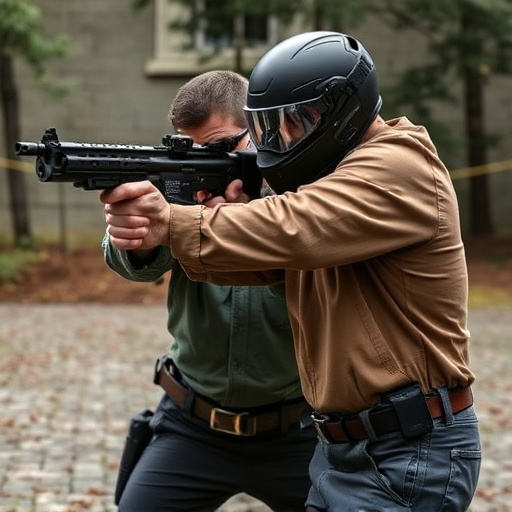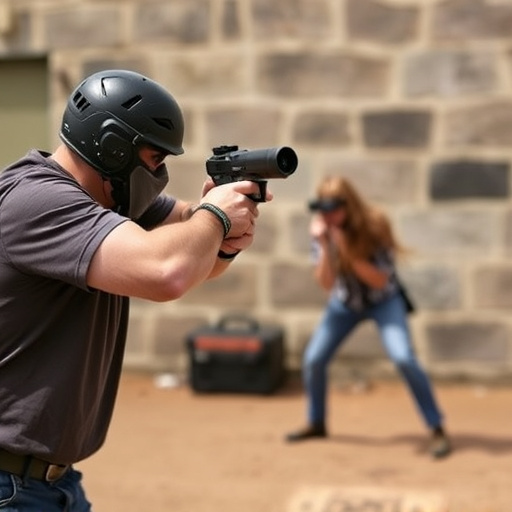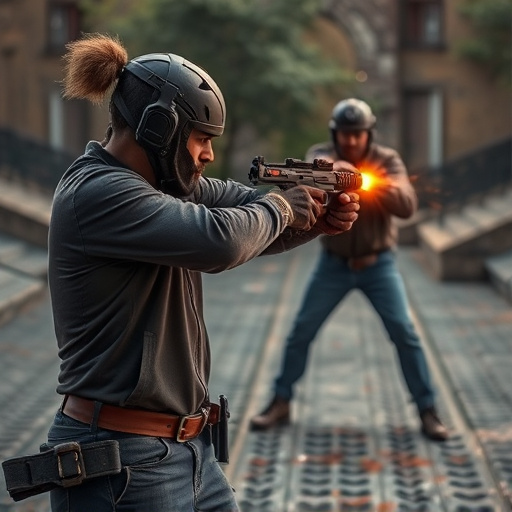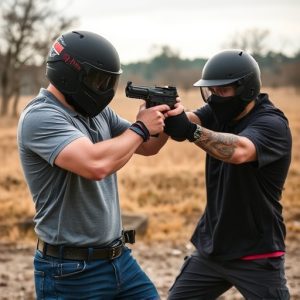Stun Gun Safety: Electrode Spacing & Effective Use for Beginners
Stun gun electrode spacing is critical for beginner users; smaller spacing enhances conductivity for…….
Stun gun electrode spacing is critical for beginner users; smaller spacing enhances conductivity for faster, more intense shocks suitable for self-defense while preventing arc formation. Devices designed for beginners feature precise spacing and safety mechanisms like automated triggers to prevent accidents. Optimal electrode arrangement immobilizes targets without severe injuries, with smart triggers guarding against accidental activation. For maximum impact and safety, beginners should maintain 1-2 inch (2.5-5 cm) spacing, use reputable brands, and practice in controlled environments. Contrary to belief, wider gaps don't equate more power; stun guns for beginners use smaller 2-3mm spacing for effective immobilization without harm.
Discover the crucial aspect of stun gun electrode spacing and its impact on effectiveness. This comprehensive guide, tailored for stun gun novices with safety in mind, breaks down the basics, explores safety features in modern devices, and demystifies how electrode placement influences performance. Learn best practices to ensure safe and effective use, while addressing common misconceptions about stun gun electrode spacing – essential knowledge for those considering self-defense tools with built-in safety mechanisms.
- Understanding Stun Gun Electrode Spacing: The Basics
- Safety Features in Stun Guns for Beginners
- How Electrode Placement Affects Stun Gun Effectiveness
- Best Practices for Using Stun Guns with Safety Mechanisms
- Common Misconceptions About Stun Gun Electrode Spacing
Understanding Stun Gun Electrode Spacing: The Basics

Stun gun electrode spacing refers to the distance between the two electrodes on a stun device, which is a critical factor in its effectiveness. For beginners using stun guns with safety features, understanding this concept is essential. Electrode spacing determines how well the electrical current can flow through the target’s body, delivering a powerful and effective shock. A smaller electrode spacing ensures better conductivity, allowing for a faster and more intense stun, which is particularly useful in self-defense scenarios.
Stun guns with safety features often have electrodes designed to minimize the risk of user injury while maximizing the impact on the attacker. Proper electrode spacing helps prevent arc formation within the device, which could cause electrical shocks or even damage to the user. It also ensures that the current flows smoothly and efficiently to the target, making it a game-changer in close-quarters combat situations.
Safety Features in Stun Guns for Beginners

Stun guns designed for beginners often come equipped with several safety features to ensure responsible use and reduce accidental discharge. One crucial aspect is the electrode spacing, which plays a vital role in the device’s effectiveness while minimizing harm to the user. Typically, stun guns have electrodes arranged in a specific pattern, ensuring optimal current flow to immobilize a target without causing severe injuries.
Beginners should look for stun guns with well-designed electrodes that maintain a safe distance from each other. Proper spacing prevents accidental zapping of nearby objects or bystanders and reduces the risk of electrical shocks. Moreover, some models feature automated safety mechanisms, such as motion sensors or smart triggers, to prevent accidental activation during transport or when not in use. These safety features are essential for first-time users who may be apprehensive about handling potentially dangerous equipment.
How Electrode Placement Affects Stun Gun Effectiveness

The placement and spacing of electrodes on a stun gun play a significant role in its effectiveness. When considering stun guns with safety features for beginners, understanding electrode positioning is key. The electric current generated by the device needs to be delivered precisely to the target area, and this is accomplished through strategic electrode design. Typically, stun guns have two electrodes, often referred to as prongs or probes, which are arranged in a specific distance apart. This spacing ensures that when the weapon makes contact with a subject, the electric current flows between the electrodes, creating a powerful shock.
Proper electrode placement allows for optimal current flow and muscle contraction, leading to immobilization. Beginners should focus on learning the correct technique for deploying stun guns, which includes aiming for vital areas like the thigh or shoulder muscles, where the electrodes make contact. The distance and alignment of these electrodes are critical; a closer spacing ensures a more concentrated shock, while proper alignment ensures the current bypasses external body parts and reaches the intended muscle groups, making the stun gun an effective self-defense tool.
Best Practices for Using Stun Guns with Safety Mechanisms

When it comes to stun guns with safety mechanisms, following best practices is paramount for both effectiveness and user safety. For beginners especially, understanding the correct electrode spacing is crucial. The general rule is to maintain a distance of approximately 1-2 inches (2.5-5 cm) between the electrodes when deploying the stun gun. This ensures optimal contact with the target, maximizing the electric current’s impact while minimizing the risk of accidental discharge or injury to bystanders.
Safety features like trigger locks and adjustable electrode positions can significantly enhance the user experience. Stun guns with these mechanisms allow for controlled deployment, ensuring the device is used precisely as intended. Beginners should take the time to familiarize themselves with these safety features, practicing in a controlled environment to gain confidence in their use. This not only ensures personal safety but also increases the likelihood of de-escalating potentially dangerous situations effectively.
Common Misconceptions About Stun Gun Electrode Spacing

Many first-time users of stun guns often have misconceptions about electrode spacing, assuming that wider gaps between electrodes mean a more powerful shock. However, this is not entirely accurate. Stun guns with safety features for beginners typically use smaller electrode spacing—often around 2–3 millimeters—to ensure effective immobilization without causing severe harm. Wider gaps might actually reduce the intensity of the electrical discharge, as it spreads across a larger area, diluting the shock’s effectiveness.
Another common misunderstanding is that more electrodes mean a stronger stun. While having multiple electrodes can help distribute the electric current more evenly, the power output is primarily determined by the stun gun’s design and the quality of its components. Beginners should focus on choosing a reliable brand known for incorporating safety features, ensuring proper electrode spacing, and offering consistent performance in various conditions.
Stun guns, equipped with safety mechanisms and optimized electrode spacing, can be powerful tools for personal protection. Understanding how electrode placement influences effectiveness is key. By adhering to best practices and avoiding common misconceptions, stun gun users—especially beginners—can maximize their device’s potential while ensuring safe and effective deployment. Stun guns with safety features designed for beginners offer peace of mind, empowering individuals to protect themselves in various situations.


